The Effect of Leadership on Employee Performance: UK SMEs Study
VerifiedAdded on 2022/08/18
|42
|12225
|21
Thesis and Dissertation
AI Summary
This dissertation investigates the effect of leadership on employee performance within Small and Medium Enterprises (SMEs) in the United Kingdom. The study begins with an introduction and proceeds to a comprehensive literature review, defining key concepts like leadership, leadership styles (transformational, transactional, laissez-faire, and autocratic), and employee performance. It explores relevant theoretical frameworks such as traits and behavioral theories, situational and contingency theories, and the transformational and transactional leadership models. The literature review also includes empirical analyses, research gaps, a conceptual framework, and hypothesis statements. The research employs a quantitative methodology, detailing the research methodology and data analysis, including sample descriptions based on age, gender, and education level. Findings are presented through statistical analyses of leadership styles and employee performance, including correlation and regression analyses to determine the relationships between leadership styles and employee performance. The dissertation concludes with a discussion of the results, conclusions, and recommendations for future research, offering valuable insights into leadership practices and their impact on employee outcomes within the context of UK SMEs.
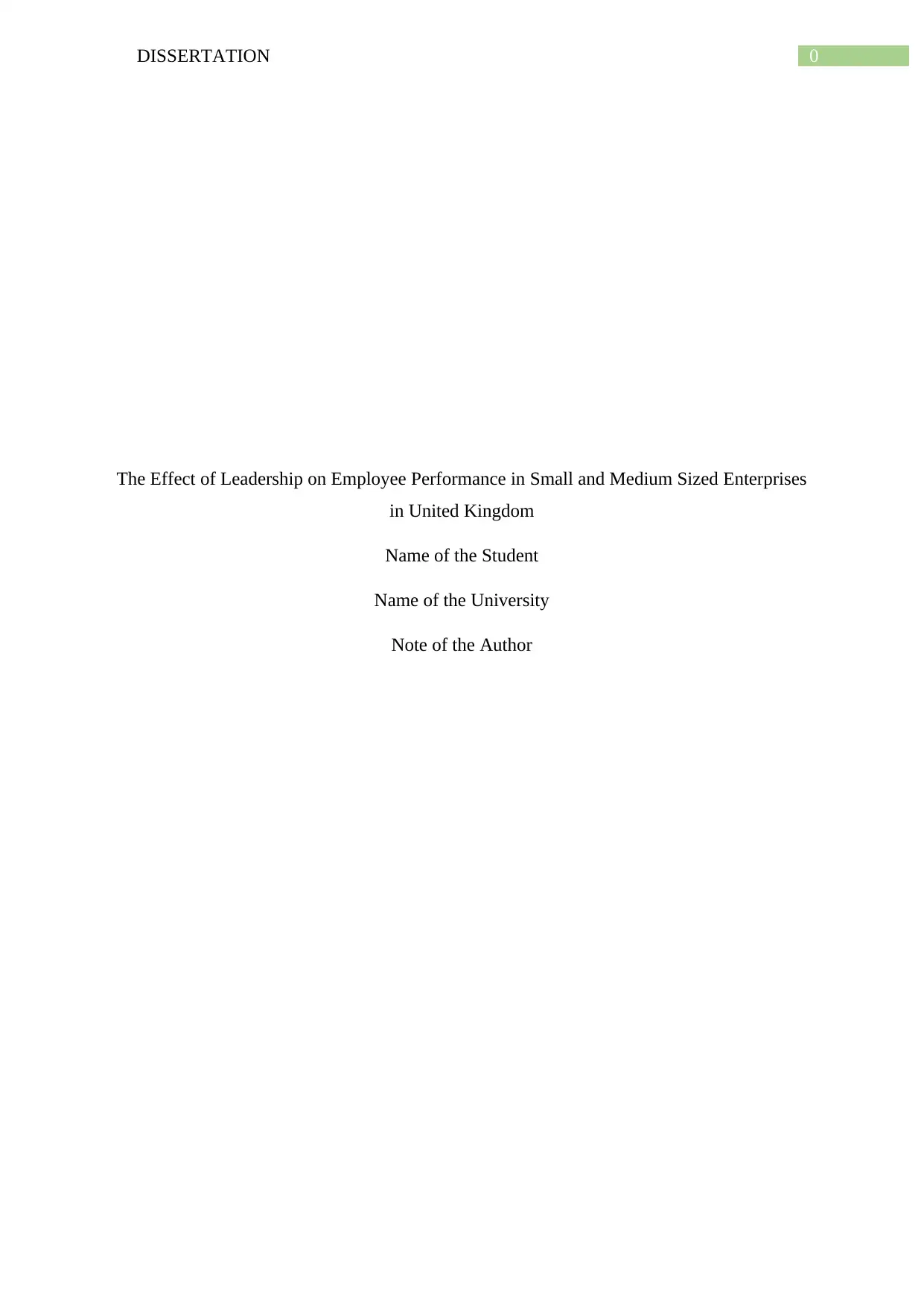
0DISSERTATION
The Effect of Leadership on Employee Performance in Small and Medium Sized Enterprises
in United Kingdom
Name of the Student
Name of the University
Note of the Author
The Effect of Leadership on Employee Performance in Small and Medium Sized Enterprises
in United Kingdom
Name of the Student
Name of the University
Note of the Author
Paraphrase This Document
Need a fresh take? Get an instant paraphrase of this document with our AI Paraphraser
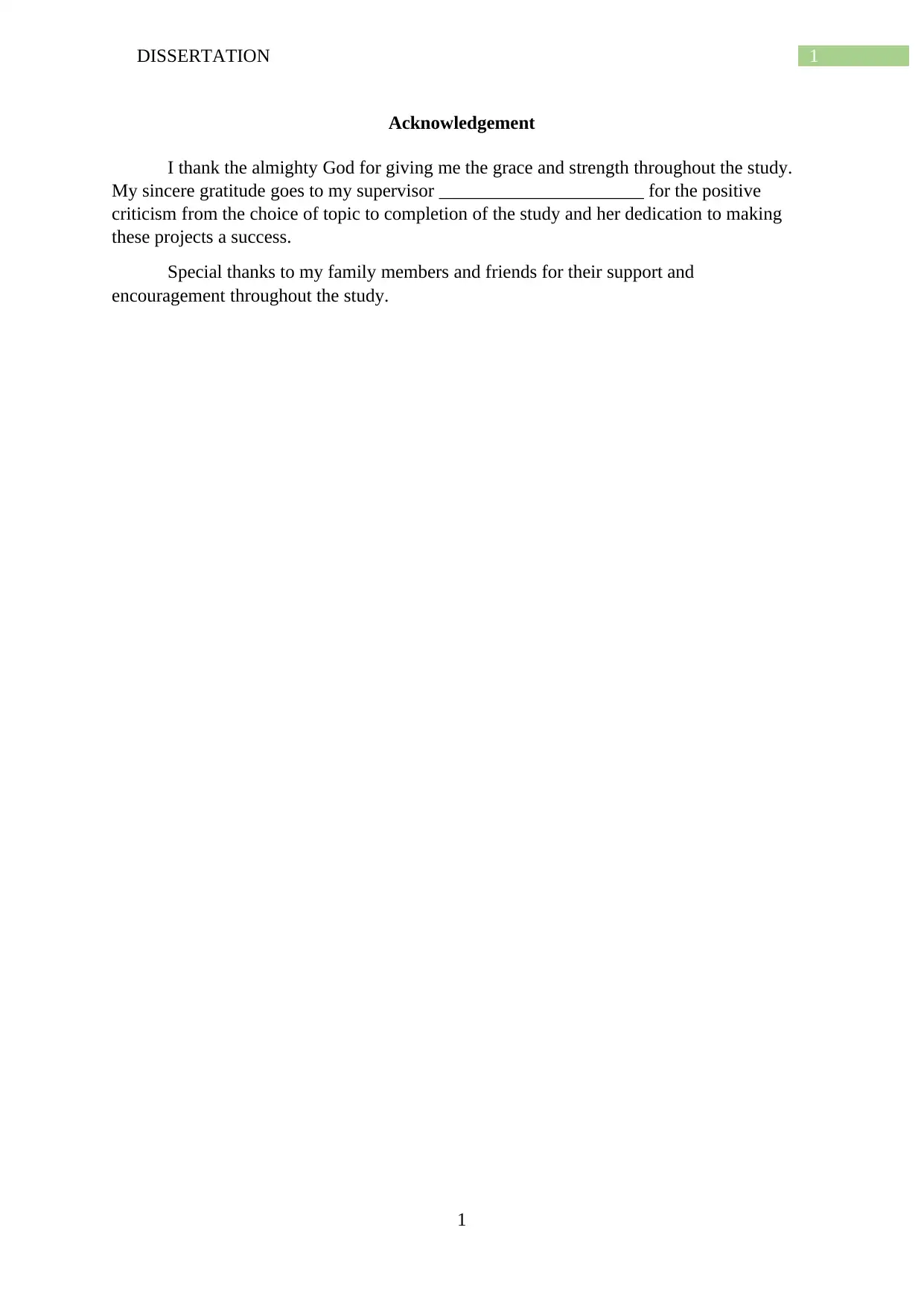
1DISSERTATION
Acknowledgement
I thank the almighty God for giving me the grace and strength throughout the study.
My sincere gratitude goes to my supervisor ______________________ for the positive
criticism from the choice of topic to completion of the study and her dedication to making
these projects a success.
Special thanks to my family members and friends for their support and
encouragement throughout the study.
1
Acknowledgement
I thank the almighty God for giving me the grace and strength throughout the study.
My sincere gratitude goes to my supervisor ______________________ for the positive
criticism from the choice of topic to completion of the study and her dedication to making
these projects a success.
Special thanks to my family members and friends for their support and
encouragement throughout the study.
1

2DISSERTATION
Abstract
2
Abstract
2
⊘ This is a preview!⊘
Do you want full access?
Subscribe today to unlock all pages.

Trusted by 1+ million students worldwide
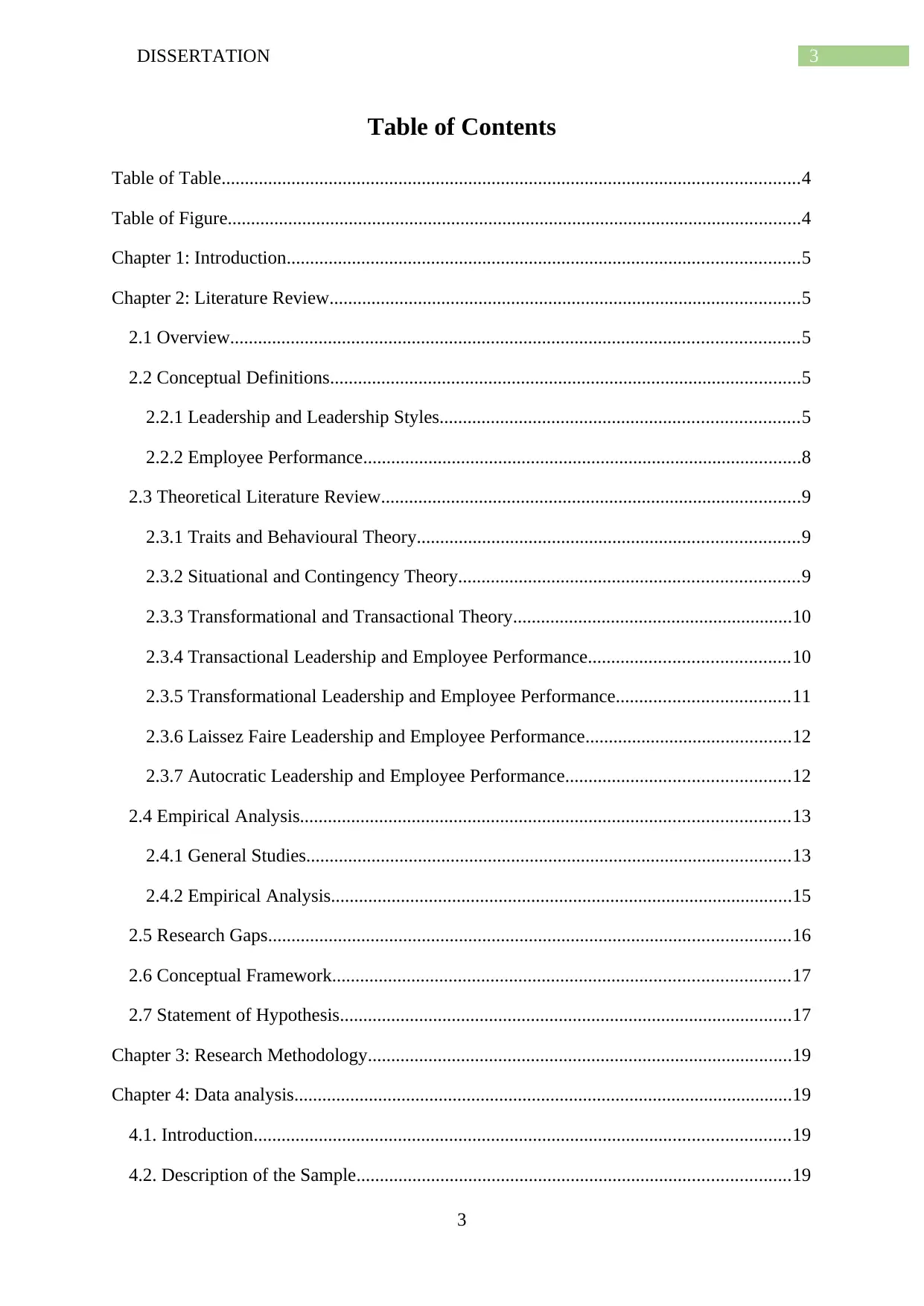
3DISSERTATION
Table of Contents
Table of Table............................................................................................................................4
Table of Figure...........................................................................................................................4
Chapter 1: Introduction..............................................................................................................5
Chapter 2: Literature Review.....................................................................................................5
2.1 Overview..........................................................................................................................5
2.2 Conceptual Definitions.....................................................................................................5
2.2.1 Leadership and Leadership Styles.............................................................................5
2.2.2 Employee Performance..............................................................................................8
2.3 Theoretical Literature Review..........................................................................................9
2.3.1 Traits and Behavioural Theory..................................................................................9
2.3.2 Situational and Contingency Theory.........................................................................9
2.3.3 Transformational and Transactional Theory............................................................10
2.3.4 Transactional Leadership and Employee Performance...........................................10
2.3.5 Transformational Leadership and Employee Performance.....................................11
2.3.6 Laissez Faire Leadership and Employee Performance............................................12
2.3.7 Autocratic Leadership and Employee Performance................................................12
2.4 Empirical Analysis.........................................................................................................13
2.4.1 General Studies........................................................................................................13
2.4.2 Empirical Analysis...................................................................................................15
2.5 Research Gaps................................................................................................................16
2.6 Conceptual Framework..................................................................................................17
2.7 Statement of Hypothesis.................................................................................................17
Chapter 3: Research Methodology...........................................................................................19
Chapter 4: Data analysis...........................................................................................................19
4.1. Introduction...................................................................................................................19
4.2. Description of the Sample.............................................................................................19
3
Table of Contents
Table of Table............................................................................................................................4
Table of Figure...........................................................................................................................4
Chapter 1: Introduction..............................................................................................................5
Chapter 2: Literature Review.....................................................................................................5
2.1 Overview..........................................................................................................................5
2.2 Conceptual Definitions.....................................................................................................5
2.2.1 Leadership and Leadership Styles.............................................................................5
2.2.2 Employee Performance..............................................................................................8
2.3 Theoretical Literature Review..........................................................................................9
2.3.1 Traits and Behavioural Theory..................................................................................9
2.3.2 Situational and Contingency Theory.........................................................................9
2.3.3 Transformational and Transactional Theory............................................................10
2.3.4 Transactional Leadership and Employee Performance...........................................10
2.3.5 Transformational Leadership and Employee Performance.....................................11
2.3.6 Laissez Faire Leadership and Employee Performance............................................12
2.3.7 Autocratic Leadership and Employee Performance................................................12
2.4 Empirical Analysis.........................................................................................................13
2.4.1 General Studies........................................................................................................13
2.4.2 Empirical Analysis...................................................................................................15
2.5 Research Gaps................................................................................................................16
2.6 Conceptual Framework..................................................................................................17
2.7 Statement of Hypothesis.................................................................................................17
Chapter 3: Research Methodology...........................................................................................19
Chapter 4: Data analysis...........................................................................................................19
4.1. Introduction...................................................................................................................19
4.2. Description of the Sample.............................................................................................19
3
Paraphrase This Document
Need a fresh take? Get an instant paraphrase of this document with our AI Paraphraser
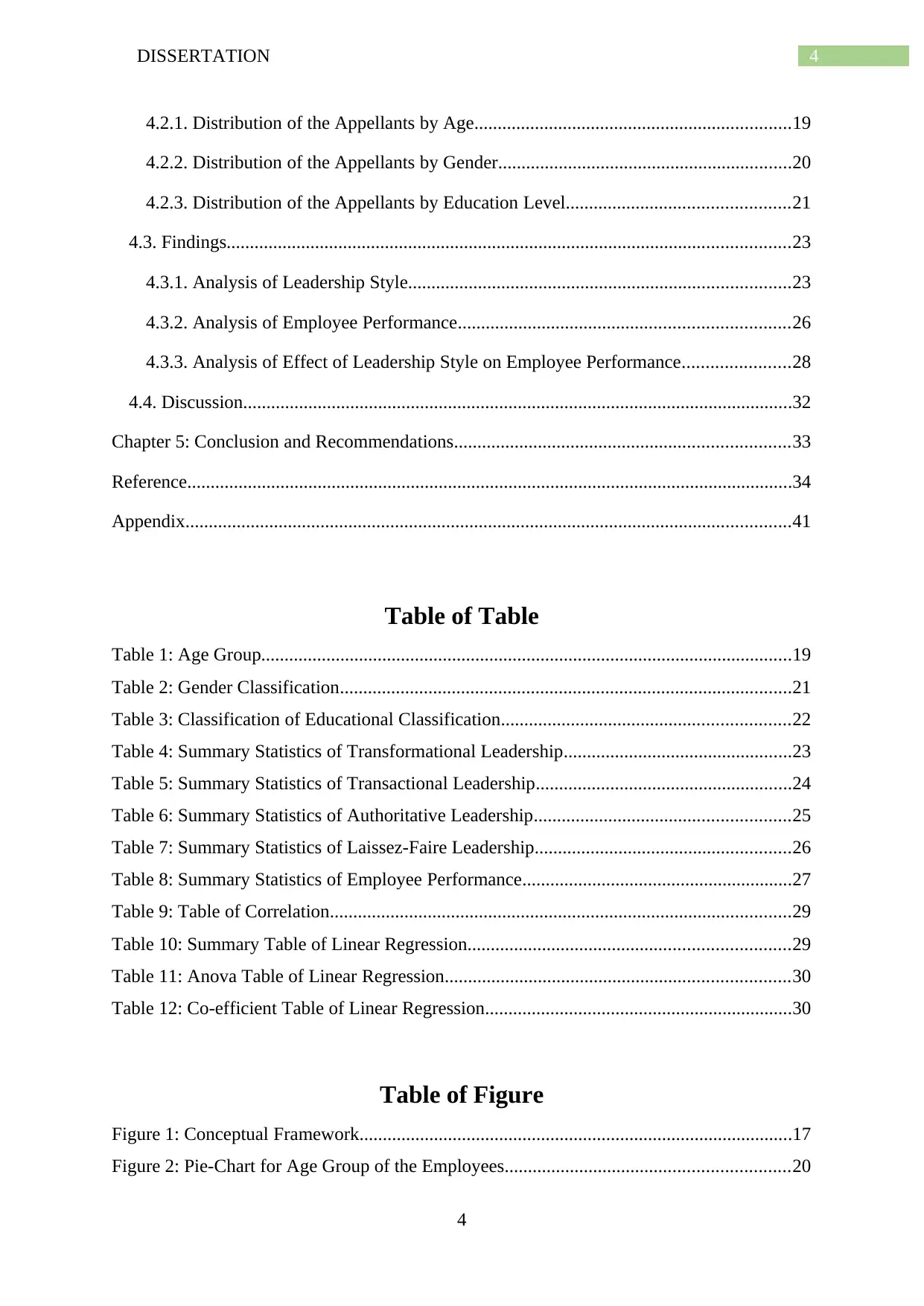
4DISSERTATION
4.2.1. Distribution of the Appellants by Age....................................................................19
4.2.2. Distribution of the Appellants by Gender...............................................................20
4.2.3. Distribution of the Appellants by Education Level................................................21
4.3. Findings.........................................................................................................................23
4.3.1. Analysis of Leadership Style..................................................................................23
4.3.2. Analysis of Employee Performance.......................................................................26
4.3.3. Analysis of Effect of Leadership Style on Employee Performance.......................28
4.4. Discussion......................................................................................................................32
Chapter 5: Conclusion and Recommendations........................................................................33
Reference..................................................................................................................................34
Appendix..................................................................................................................................41
Table of Table
Table 1: Age Group..................................................................................................................19
Table 2: Gender Classification.................................................................................................21
Table 3: Classification of Educational Classification..............................................................22
Table 4: Summary Statistics of Transformational Leadership.................................................23
Table 5: Summary Statistics of Transactional Leadership.......................................................24
Table 6: Summary Statistics of Authoritative Leadership.......................................................25
Table 7: Summary Statistics of Laissez-Faire Leadership.......................................................26
Table 8: Summary Statistics of Employee Performance..........................................................27
Table 9: Table of Correlation...................................................................................................29
Table 10: Summary Table of Linear Regression.....................................................................29
Table 11: Anova Table of Linear Regression..........................................................................30
Table 12: Co-efficient Table of Linear Regression..................................................................30
Table of Figure
Figure 1: Conceptual Framework.............................................................................................17
Figure 2: Pie-Chart for Age Group of the Employees.............................................................20
4
4.2.1. Distribution of the Appellants by Age....................................................................19
4.2.2. Distribution of the Appellants by Gender...............................................................20
4.2.3. Distribution of the Appellants by Education Level................................................21
4.3. Findings.........................................................................................................................23
4.3.1. Analysis of Leadership Style..................................................................................23
4.3.2. Analysis of Employee Performance.......................................................................26
4.3.3. Analysis of Effect of Leadership Style on Employee Performance.......................28
4.4. Discussion......................................................................................................................32
Chapter 5: Conclusion and Recommendations........................................................................33
Reference..................................................................................................................................34
Appendix..................................................................................................................................41
Table of Table
Table 1: Age Group..................................................................................................................19
Table 2: Gender Classification.................................................................................................21
Table 3: Classification of Educational Classification..............................................................22
Table 4: Summary Statistics of Transformational Leadership.................................................23
Table 5: Summary Statistics of Transactional Leadership.......................................................24
Table 6: Summary Statistics of Authoritative Leadership.......................................................25
Table 7: Summary Statistics of Laissez-Faire Leadership.......................................................26
Table 8: Summary Statistics of Employee Performance..........................................................27
Table 9: Table of Correlation...................................................................................................29
Table 10: Summary Table of Linear Regression.....................................................................29
Table 11: Anova Table of Linear Regression..........................................................................30
Table 12: Co-efficient Table of Linear Regression..................................................................30
Table of Figure
Figure 1: Conceptual Framework.............................................................................................17
Figure 2: Pie-Chart for Age Group of the Employees.............................................................20
4
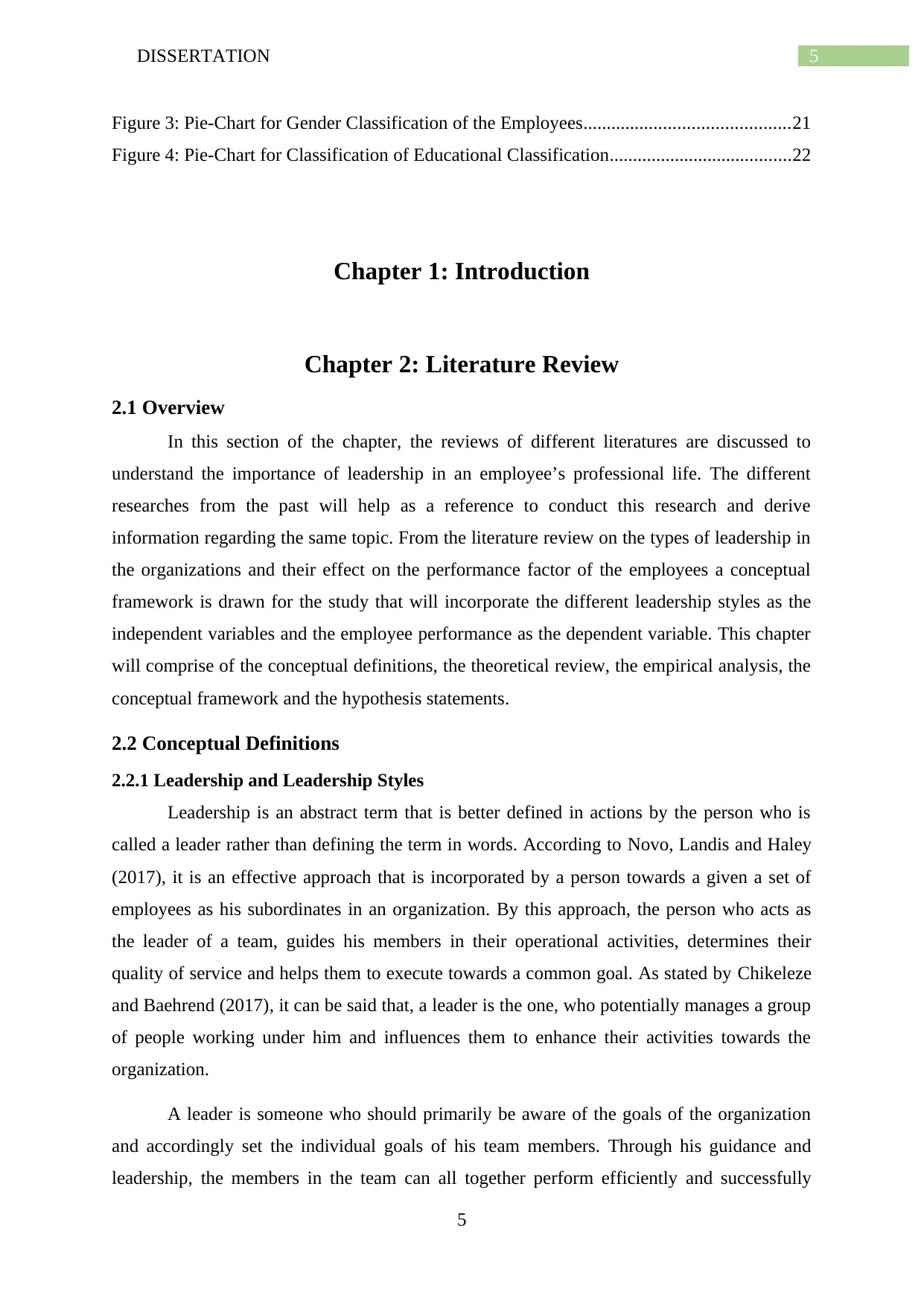
5DISSERTATION
Figure 3: Pie-Chart for Gender Classification of the Employees............................................21
Figure 4: Pie-Chart for Classification of Educational Classification.......................................22
Chapter 1: Introduction
Chapter 2: Literature Review
2.1 Overview
In this section of the chapter, the reviews of different literatures are discussed to
understand the importance of leadership in an employee’s professional life. The different
researches from the past will help as a reference to conduct this research and derive
information regarding the same topic. From the literature review on the types of leadership in
the organizations and their effect on the performance factor of the employees a conceptual
framework is drawn for the study that will incorporate the different leadership styles as the
independent variables and the employee performance as the dependent variable. This chapter
will comprise of the conceptual definitions, the theoretical review, the empirical analysis, the
conceptual framework and the hypothesis statements.
2.2 Conceptual Definitions
2.2.1 Leadership and Leadership Styles
Leadership is an abstract term that is better defined in actions by the person who is
called a leader rather than defining the term in words. According to Novo, Landis and Haley
(2017), it is an effective approach that is incorporated by a person towards a given a set of
employees as his subordinates in an organization. By this approach, the person who acts as
the leader of a team, guides his members in their operational activities, determines their
quality of service and helps them to execute towards a common goal. As stated by Chikeleze
and Baehrend (2017), it can be said that, a leader is the one, who potentially manages a group
of people working under him and influences them to enhance their activities towards the
organization.
A leader is someone who should primarily be aware of the goals of the organization
and accordingly set the individual goals of his team members. Through his guidance and
leadership, the members in the team can all together perform efficiently and successfully
5
Figure 3: Pie-Chart for Gender Classification of the Employees............................................21
Figure 4: Pie-Chart for Classification of Educational Classification.......................................22
Chapter 1: Introduction
Chapter 2: Literature Review
2.1 Overview
In this section of the chapter, the reviews of different literatures are discussed to
understand the importance of leadership in an employee’s professional life. The different
researches from the past will help as a reference to conduct this research and derive
information regarding the same topic. From the literature review on the types of leadership in
the organizations and their effect on the performance factor of the employees a conceptual
framework is drawn for the study that will incorporate the different leadership styles as the
independent variables and the employee performance as the dependent variable. This chapter
will comprise of the conceptual definitions, the theoretical review, the empirical analysis, the
conceptual framework and the hypothesis statements.
2.2 Conceptual Definitions
2.2.1 Leadership and Leadership Styles
Leadership is an abstract term that is better defined in actions by the person who is
called a leader rather than defining the term in words. According to Novo, Landis and Haley
(2017), it is an effective approach that is incorporated by a person towards a given a set of
employees as his subordinates in an organization. By this approach, the person who acts as
the leader of a team, guides his members in their operational activities, determines their
quality of service and helps them to execute towards a common goal. As stated by Chikeleze
and Baehrend (2017), it can be said that, a leader is the one, who potentially manages a group
of people working under him and influences them to enhance their activities towards the
organization.
A leader is someone who should primarily be aware of the goals of the organization
and accordingly set the individual goals of his team members. Through his guidance and
leadership, the members in the team can all together perform efficiently and successfully
5
⊘ This is a preview!⊘
Do you want full access?
Subscribe today to unlock all pages.

Trusted by 1+ million students worldwide
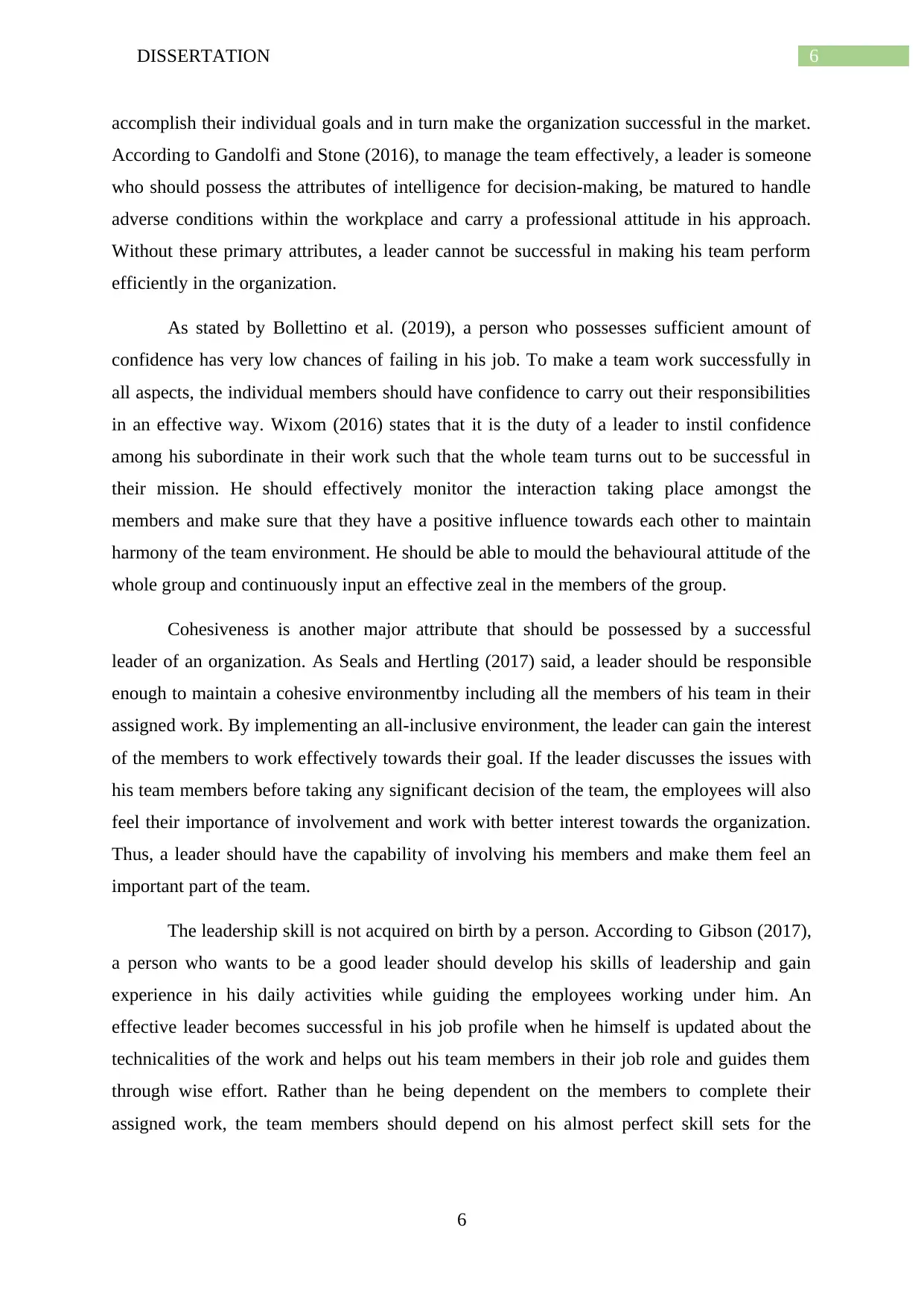
6DISSERTATION
accomplish their individual goals and in turn make the organization successful in the market.
According to Gandolfi and Stone (2016), to manage the team effectively, a leader is someone
who should possess the attributes of intelligence for decision-making, be matured to handle
adverse conditions within the workplace and carry a professional attitude in his approach.
Without these primary attributes, a leader cannot be successful in making his team perform
efficiently in the organization.
As stated by Bollettino et al. (2019), a person who possesses sufficient amount of
confidence has very low chances of failing in his job. To make a team work successfully in
all aspects, the individual members should have confidence to carry out their responsibilities
in an effective way. Wixom (2016) states that it is the duty of a leader to instil confidence
among his subordinate in their work such that the whole team turns out to be successful in
their mission. He should effectively monitor the interaction taking place amongst the
members and make sure that they have a positive influence towards each other to maintain
harmony of the team environment. He should be able to mould the behavioural attitude of the
whole group and continuously input an effective zeal in the members of the group.
Cohesiveness is another major attribute that should be possessed by a successful
leader of an organization. As Seals and Hertling (2017) said, a leader should be responsible
enough to maintain a cohesive environmentby including all the members of his team in their
assigned work. By implementing an all-inclusive environment, the leader can gain the interest
of the members to work effectively towards their goal. If the leader discusses the issues with
his team members before taking any significant decision of the team, the employees will also
feel their importance of involvement and work with better interest towards the organization.
Thus, a leader should have the capability of involving his members and make them feel an
important part of the team.
The leadership skill is not acquired on birth by a person. According to Gibson (2017),
a person who wants to be a good leader should develop his skills of leadership and gain
experience in his daily activities while guiding the employees working under him. An
effective leader becomes successful in his job profile when he himself is updated about the
technicalities of the work and helps out his team members in their job role and guides them
through wise effort. Rather than he being dependent on the members to complete their
assigned work, the team members should depend on his almost perfect skill sets for the
6
accomplish their individual goals and in turn make the organization successful in the market.
According to Gandolfi and Stone (2016), to manage the team effectively, a leader is someone
who should possess the attributes of intelligence for decision-making, be matured to handle
adverse conditions within the workplace and carry a professional attitude in his approach.
Without these primary attributes, a leader cannot be successful in making his team perform
efficiently in the organization.
As stated by Bollettino et al. (2019), a person who possesses sufficient amount of
confidence has very low chances of failing in his job. To make a team work successfully in
all aspects, the individual members should have confidence to carry out their responsibilities
in an effective way. Wixom (2016) states that it is the duty of a leader to instil confidence
among his subordinate in their work such that the whole team turns out to be successful in
their mission. He should effectively monitor the interaction taking place amongst the
members and make sure that they have a positive influence towards each other to maintain
harmony of the team environment. He should be able to mould the behavioural attitude of the
whole group and continuously input an effective zeal in the members of the group.
Cohesiveness is another major attribute that should be possessed by a successful
leader of an organization. As Seals and Hertling (2017) said, a leader should be responsible
enough to maintain a cohesive environmentby including all the members of his team in their
assigned work. By implementing an all-inclusive environment, the leader can gain the interest
of the members to work effectively towards their goal. If the leader discusses the issues with
his team members before taking any significant decision of the team, the employees will also
feel their importance of involvement and work with better interest towards the organization.
Thus, a leader should have the capability of involving his members and make them feel an
important part of the team.
The leadership skill is not acquired on birth by a person. According to Gibson (2017),
a person who wants to be a good leader should develop his skills of leadership and gain
experience in his daily activities while guiding the employees working under him. An
effective leader becomes successful in his job profile when he himself is updated about the
technicalities of the work and helps out his team members in their job role and guides them
through wise effort. Rather than he being dependent on the members to complete their
assigned work, the team members should depend on his almost perfect skill sets for the
6
Paraphrase This Document
Need a fresh take? Get an instant paraphrase of this document with our AI Paraphraser
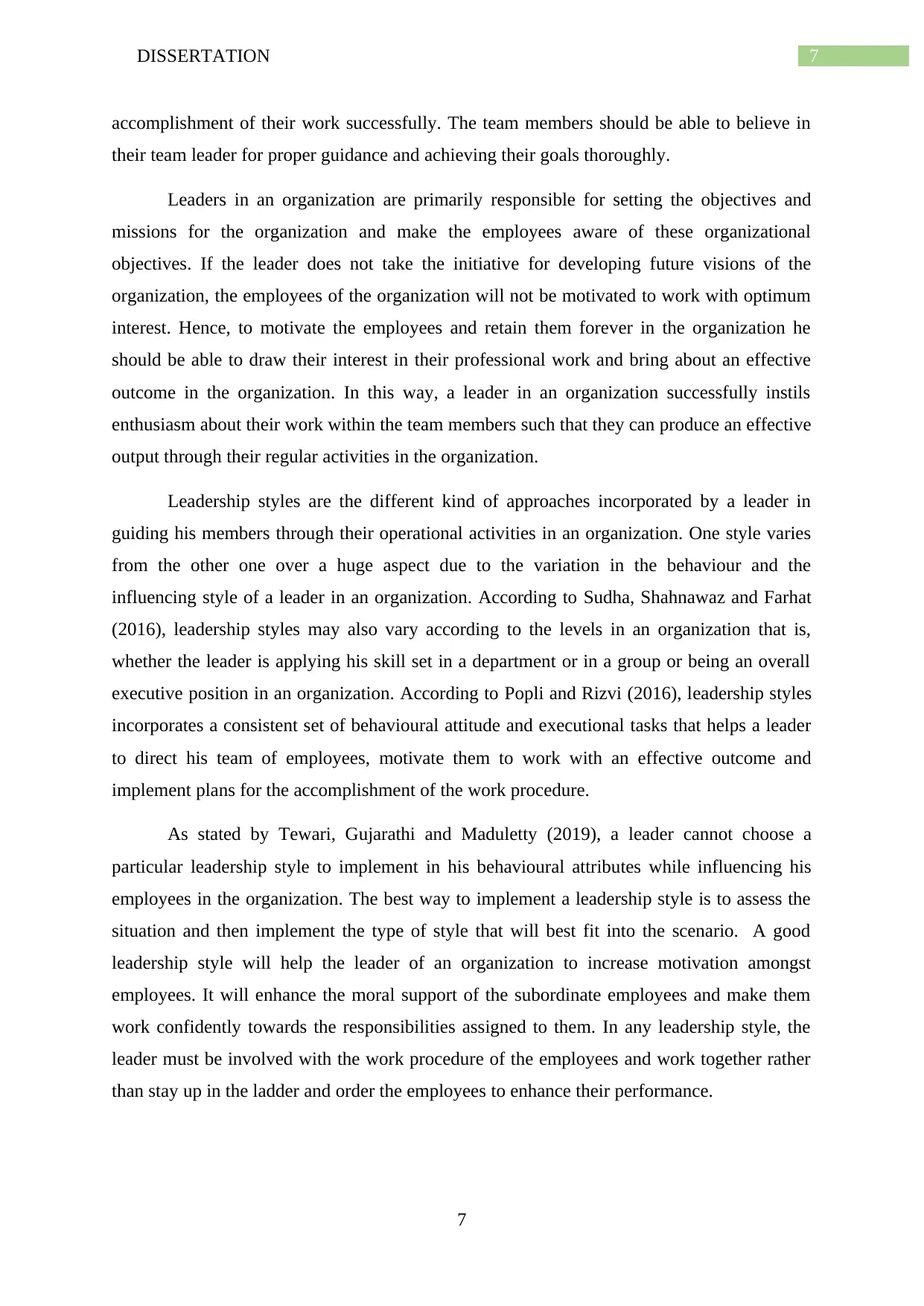
7DISSERTATION
accomplishment of their work successfully. The team members should be able to believe in
their team leader for proper guidance and achieving their goals thoroughly.
Leaders in an organization are primarily responsible for setting the objectives and
missions for the organization and make the employees aware of these organizational
objectives. If the leader does not take the initiative for developing future visions of the
organization, the employees of the organization will not be motivated to work with optimum
interest. Hence, to motivate the employees and retain them forever in the organization he
should be able to draw their interest in their professional work and bring about an effective
outcome in the organization. In this way, a leader in an organization successfully instils
enthusiasm about their work within the team members such that they can produce an effective
output through their regular activities in the organization.
Leadership styles are the different kind of approaches incorporated by a leader in
guiding his members through their operational activities in an organization. One style varies
from the other one over a huge aspect due to the variation in the behaviour and the
influencing style of a leader in an organization. According to Sudha, Shahnawaz and Farhat
(2016), leadership styles may also vary according to the levels in an organization that is,
whether the leader is applying his skill set in a department or in a group or being an overall
executive position in an organization. According to Popli and Rizvi (2016), leadership styles
incorporates a consistent set of behavioural attitude and executional tasks that helps a leader
to direct his team of employees, motivate them to work with an effective outcome and
implement plans for the accomplishment of the work procedure.
As stated by Tewari, Gujarathi and Maduletty (2019), a leader cannot choose a
particular leadership style to implement in his behavioural attributes while influencing his
employees in the organization. The best way to implement a leadership style is to assess the
situation and then implement the type of style that will best fit into the scenario. A good
leadership style will help the leader of an organization to increase motivation amongst
employees. It will enhance the moral support of the subordinate employees and make them
work confidently towards the responsibilities assigned to them. In any leadership style, the
leader must be involved with the work procedure of the employees and work together rather
than stay up in the ladder and order the employees to enhance their performance.
7
accomplishment of their work successfully. The team members should be able to believe in
their team leader for proper guidance and achieving their goals thoroughly.
Leaders in an organization are primarily responsible for setting the objectives and
missions for the organization and make the employees aware of these organizational
objectives. If the leader does not take the initiative for developing future visions of the
organization, the employees of the organization will not be motivated to work with optimum
interest. Hence, to motivate the employees and retain them forever in the organization he
should be able to draw their interest in their professional work and bring about an effective
outcome in the organization. In this way, a leader in an organization successfully instils
enthusiasm about their work within the team members such that they can produce an effective
output through their regular activities in the organization.
Leadership styles are the different kind of approaches incorporated by a leader in
guiding his members through their operational activities in an organization. One style varies
from the other one over a huge aspect due to the variation in the behaviour and the
influencing style of a leader in an organization. According to Sudha, Shahnawaz and Farhat
(2016), leadership styles may also vary according to the levels in an organization that is,
whether the leader is applying his skill set in a department or in a group or being an overall
executive position in an organization. According to Popli and Rizvi (2016), leadership styles
incorporates a consistent set of behavioural attitude and executional tasks that helps a leader
to direct his team of employees, motivate them to work with an effective outcome and
implement plans for the accomplishment of the work procedure.
As stated by Tewari, Gujarathi and Maduletty (2019), a leader cannot choose a
particular leadership style to implement in his behavioural attributes while influencing his
employees in the organization. The best way to implement a leadership style is to assess the
situation and then implement the type of style that will best fit into the scenario. A good
leadership style will help the leader of an organization to increase motivation amongst
employees. It will enhance the moral support of the subordinate employees and make them
work confidently towards the responsibilities assigned to them. In any leadership style, the
leader must be involved with the work procedure of the employees and work together rather
than stay up in the ladder and order the employees to enhance their performance.
7
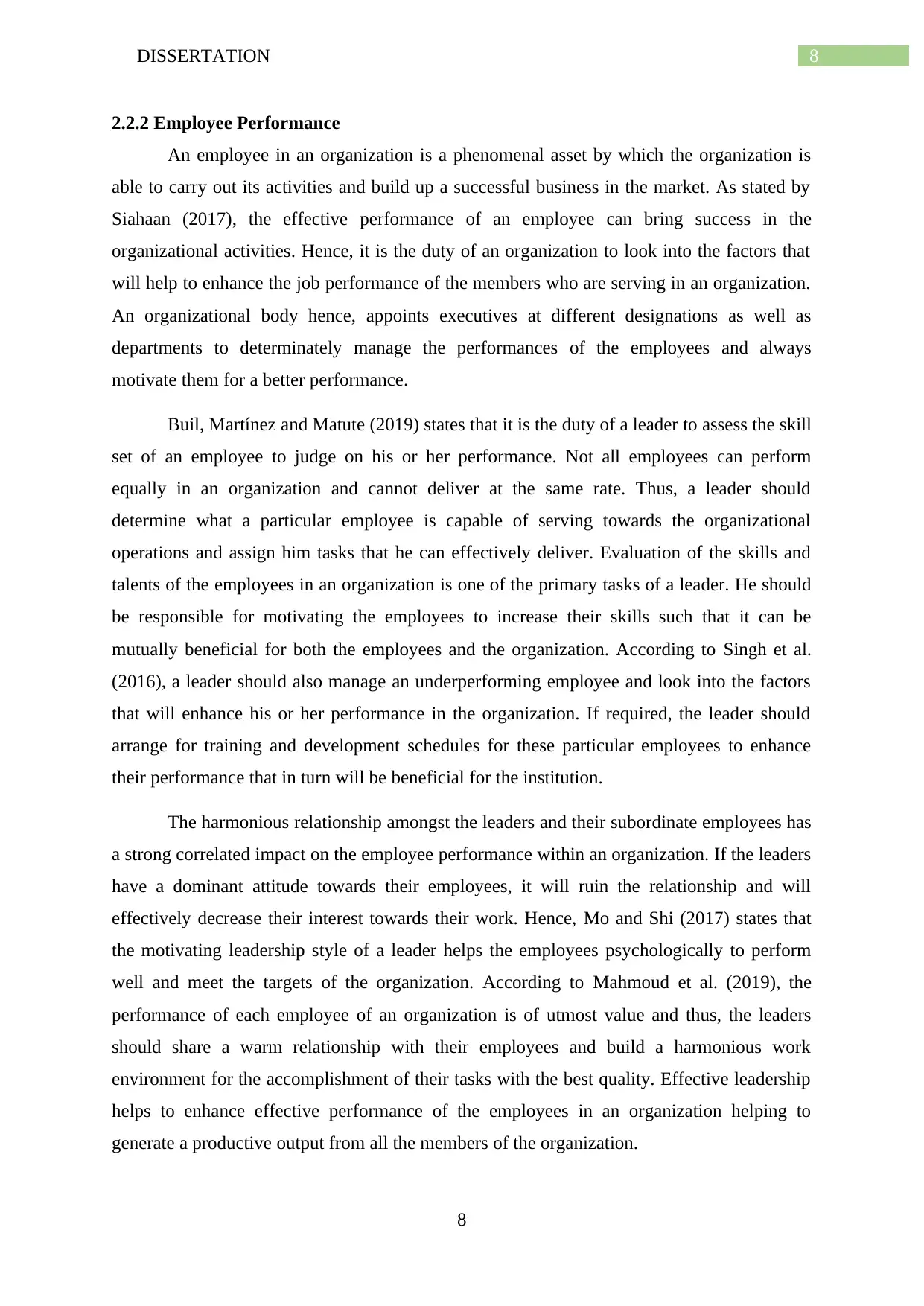
8DISSERTATION
2.2.2 Employee Performance
An employee in an organization is a phenomenal asset by which the organization is
able to carry out its activities and build up a successful business in the market. As stated by
Siahaan (2017), the effective performance of an employee can bring success in the
organizational activities. Hence, it is the duty of an organization to look into the factors that
will help to enhance the job performance of the members who are serving in an organization.
An organizational body hence, appoints executives at different designations as well as
departments to determinately manage the performances of the employees and always
motivate them for a better performance.
Buil, Martínez and Matute (2019) states that it is the duty of a leader to assess the skill
set of an employee to judge on his or her performance. Not all employees can perform
equally in an organization and cannot deliver at the same rate. Thus, a leader should
determine what a particular employee is capable of serving towards the organizational
operations and assign him tasks that he can effectively deliver. Evaluation of the skills and
talents of the employees in an organization is one of the primary tasks of a leader. He should
be responsible for motivating the employees to increase their skills such that it can be
mutually beneficial for both the employees and the organization. According to Singh et al.
(2016), a leader should also manage an underperforming employee and look into the factors
that will enhance his or her performance in the organization. If required, the leader should
arrange for training and development schedules for these particular employees to enhance
their performance that in turn will be beneficial for the institution.
The harmonious relationship amongst the leaders and their subordinate employees has
a strong correlated impact on the employee performance within an organization. If the leaders
have a dominant attitude towards their employees, it will ruin the relationship and will
effectively decrease their interest towards their work. Hence, Mo and Shi (2017) states that
the motivating leadership style of a leader helps the employees psychologically to perform
well and meet the targets of the organization. According to Mahmoud et al. (2019), the
performance of each employee of an organization is of utmost value and thus, the leaders
should share a warm relationship with their employees and build a harmonious work
environment for the accomplishment of their tasks with the best quality. Effective leadership
helps to enhance effective performance of the employees in an organization helping to
generate a productive output from all the members of the organization.
8
2.2.2 Employee Performance
An employee in an organization is a phenomenal asset by which the organization is
able to carry out its activities and build up a successful business in the market. As stated by
Siahaan (2017), the effective performance of an employee can bring success in the
organizational activities. Hence, it is the duty of an organization to look into the factors that
will help to enhance the job performance of the members who are serving in an organization.
An organizational body hence, appoints executives at different designations as well as
departments to determinately manage the performances of the employees and always
motivate them for a better performance.
Buil, Martínez and Matute (2019) states that it is the duty of a leader to assess the skill
set of an employee to judge on his or her performance. Not all employees can perform
equally in an organization and cannot deliver at the same rate. Thus, a leader should
determine what a particular employee is capable of serving towards the organizational
operations and assign him tasks that he can effectively deliver. Evaluation of the skills and
talents of the employees in an organization is one of the primary tasks of a leader. He should
be responsible for motivating the employees to increase their skills such that it can be
mutually beneficial for both the employees and the organization. According to Singh et al.
(2016), a leader should also manage an underperforming employee and look into the factors
that will enhance his or her performance in the organization. If required, the leader should
arrange for training and development schedules for these particular employees to enhance
their performance that in turn will be beneficial for the institution.
The harmonious relationship amongst the leaders and their subordinate employees has
a strong correlated impact on the employee performance within an organization. If the leaders
have a dominant attitude towards their employees, it will ruin the relationship and will
effectively decrease their interest towards their work. Hence, Mo and Shi (2017) states that
the motivating leadership style of a leader helps the employees psychologically to perform
well and meet the targets of the organization. According to Mahmoud et al. (2019), the
performance of each employee of an organization is of utmost value and thus, the leaders
should share a warm relationship with their employees and build a harmonious work
environment for the accomplishment of their tasks with the best quality. Effective leadership
helps to enhance effective performance of the employees in an organization helping to
generate a productive output from all the members of the organization.
8
⊘ This is a preview!⊘
Do you want full access?
Subscribe today to unlock all pages.

Trusted by 1+ million students worldwide
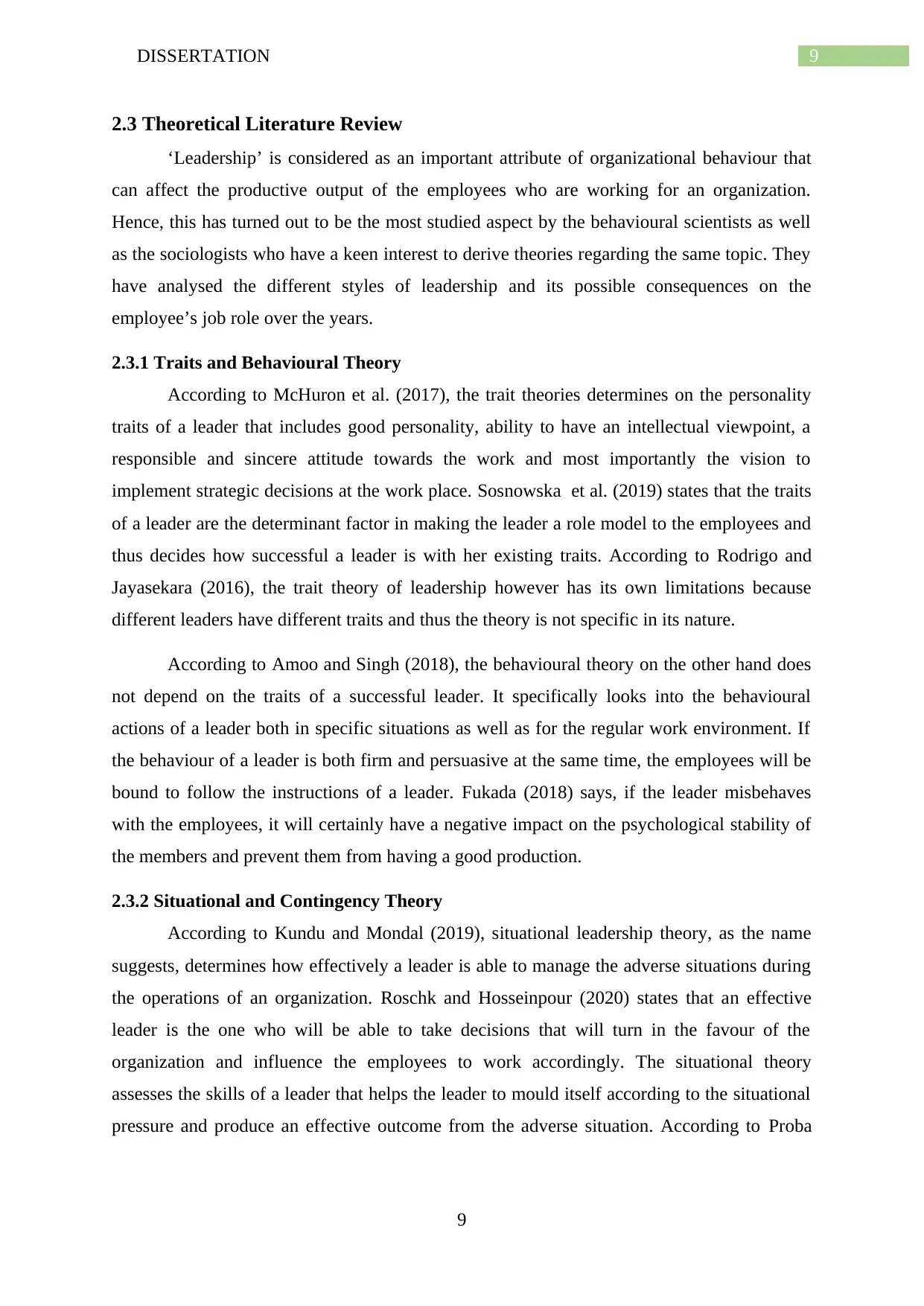
9DISSERTATION
2.3 Theoretical Literature Review
‘Leadership’ is considered as an important attribute of organizational behaviour that
can affect the productive output of the employees who are working for an organization.
Hence, this has turned out to be the most studied aspect by the behavioural scientists as well
as the sociologists who have a keen interest to derive theories regarding the same topic. They
have analysed the different styles of leadership and its possible consequences on the
employee’s job role over the years.
2.3.1 Traits and Behavioural Theory
According to McHuron et al. (2017), the trait theories determines on the personality
traits of a leader that includes good personality, ability to have an intellectual viewpoint, a
responsible and sincere attitude towards the work and most importantly the vision to
implement strategic decisions at the work place. Sosnowska et al. (2019) states that the traits
of a leader are the determinant factor in making the leader a role model to the employees and
thus decides how successful a leader is with her existing traits. According to Rodrigo and
Jayasekara (2016), the trait theory of leadership however has its own limitations because
different leaders have different traits and thus the theory is not specific in its nature.
According to Amoo and Singh (2018), the behavioural theory on the other hand does
not depend on the traits of a successful leader. It specifically looks into the behavioural
actions of a leader both in specific situations as well as for the regular work environment. If
the behaviour of a leader is both firm and persuasive at the same time, the employees will be
bound to follow the instructions of a leader. Fukada (2018) says, if the leader misbehaves
with the employees, it will certainly have a negative impact on the psychological stability of
the members and prevent them from having a good production.
2.3.2 Situational and Contingency Theory
According to Kundu and Mondal (2019), situational leadership theory, as the name
suggests, determines how effectively a leader is able to manage the adverse situations during
the operations of an organization. Roschk and Hosseinpour (2020) states that an effective
leader is the one who will be able to take decisions that will turn in the favour of the
organization and influence the employees to work accordingly. The situational theory
assesses the skills of a leader that helps the leader to mould itself according to the situational
pressure and produce an effective outcome from the adverse situation. According to Proba
9
2.3 Theoretical Literature Review
‘Leadership’ is considered as an important attribute of organizational behaviour that
can affect the productive output of the employees who are working for an organization.
Hence, this has turned out to be the most studied aspect by the behavioural scientists as well
as the sociologists who have a keen interest to derive theories regarding the same topic. They
have analysed the different styles of leadership and its possible consequences on the
employee’s job role over the years.
2.3.1 Traits and Behavioural Theory
According to McHuron et al. (2017), the trait theories determines on the personality
traits of a leader that includes good personality, ability to have an intellectual viewpoint, a
responsible and sincere attitude towards the work and most importantly the vision to
implement strategic decisions at the work place. Sosnowska et al. (2019) states that the traits
of a leader are the determinant factor in making the leader a role model to the employees and
thus decides how successful a leader is with her existing traits. According to Rodrigo and
Jayasekara (2016), the trait theory of leadership however has its own limitations because
different leaders have different traits and thus the theory is not specific in its nature.
According to Amoo and Singh (2018), the behavioural theory on the other hand does
not depend on the traits of a successful leader. It specifically looks into the behavioural
actions of a leader both in specific situations as well as for the regular work environment. If
the behaviour of a leader is both firm and persuasive at the same time, the employees will be
bound to follow the instructions of a leader. Fukada (2018) says, if the leader misbehaves
with the employees, it will certainly have a negative impact on the psychological stability of
the members and prevent them from having a good production.
2.3.2 Situational and Contingency Theory
According to Kundu and Mondal (2019), situational leadership theory, as the name
suggests, determines how effectively a leader is able to manage the adverse situations during
the operations of an organization. Roschk and Hosseinpour (2020) states that an effective
leader is the one who will be able to take decisions that will turn in the favour of the
organization and influence the employees to work accordingly. The situational theory
assesses the skills of a leader that helps the leader to mould itself according to the situational
pressure and produce an effective outcome from the adverse situation. According to Proba
9
Paraphrase This Document
Need a fresh take? Get an instant paraphrase of this document with our AI Paraphraser
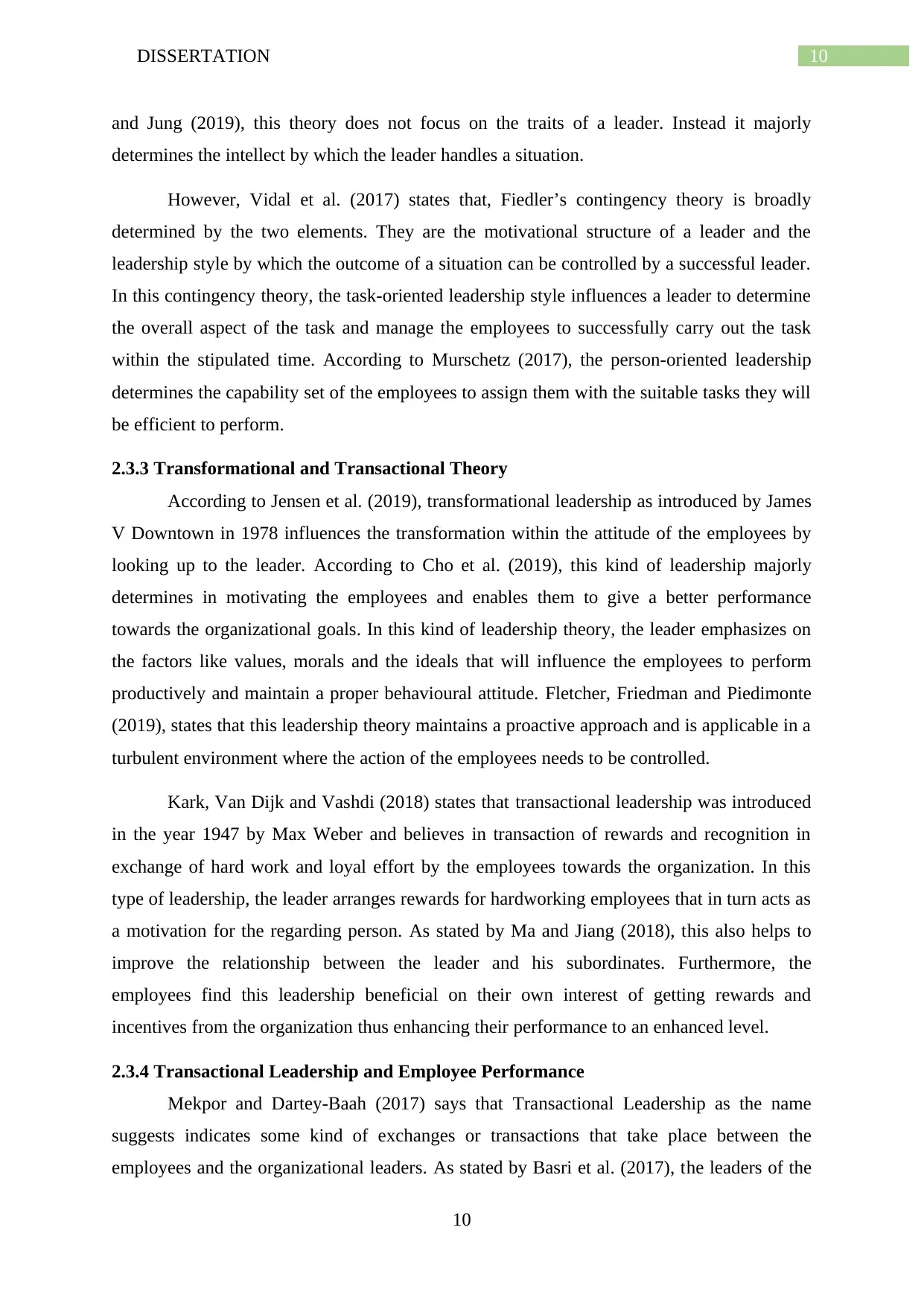
10DISSERTATION
and Jung (2019), this theory does not focus on the traits of a leader. Instead it majorly
determines the intellect by which the leader handles a situation.
However, Vidal et al. (2017) states that, Fiedler’s contingency theory is broadly
determined by the two elements. They are the motivational structure of a leader and the
leadership style by which the outcome of a situation can be controlled by a successful leader.
In this contingency theory, the task-oriented leadership style influences a leader to determine
the overall aspect of the task and manage the employees to successfully carry out the task
within the stipulated time. According to Murschetz (2017), the person-oriented leadership
determines the capability set of the employees to assign them with the suitable tasks they will
be efficient to perform.
2.3.3 Transformational and Transactional Theory
According to Jensen et al. (2019), transformational leadership as introduced by James
V Downtown in 1978 influences the transformation within the attitude of the employees by
looking up to the leader. According to Cho et al. (2019), this kind of leadership majorly
determines in motivating the employees and enables them to give a better performance
towards the organizational goals. In this kind of leadership theory, the leader emphasizes on
the factors like values, morals and the ideals that will influence the employees to perform
productively and maintain a proper behavioural attitude. Fletcher, Friedman and Piedimonte
(2019), states that this leadership theory maintains a proactive approach and is applicable in a
turbulent environment where the action of the employees needs to be controlled.
Kark, Van Dijk and Vashdi (2018) states that transactional leadership was introduced
in the year 1947 by Max Weber and believes in transaction of rewards and recognition in
exchange of hard work and loyal effort by the employees towards the organization. In this
type of leadership, the leader arranges rewards for hardworking employees that in turn acts as
a motivation for the regarding person. As stated by Ma and Jiang (2018), this also helps to
improve the relationship between the leader and his subordinates. Furthermore, the
employees find this leadership beneficial on their own interest of getting rewards and
incentives from the organization thus enhancing their performance to an enhanced level.
2.3.4 Transactional Leadership and Employee Performance
Mekpor and Dartey-Baah (2017) says that Transactional Leadership as the name
suggests indicates some kind of exchanges or transactions that take place between the
employees and the organizational leaders. As stated by Basri et al. (2017), the leaders of the
10
and Jung (2019), this theory does not focus on the traits of a leader. Instead it majorly
determines the intellect by which the leader handles a situation.
However, Vidal et al. (2017) states that, Fiedler’s contingency theory is broadly
determined by the two elements. They are the motivational structure of a leader and the
leadership style by which the outcome of a situation can be controlled by a successful leader.
In this contingency theory, the task-oriented leadership style influences a leader to determine
the overall aspect of the task and manage the employees to successfully carry out the task
within the stipulated time. According to Murschetz (2017), the person-oriented leadership
determines the capability set of the employees to assign them with the suitable tasks they will
be efficient to perform.
2.3.3 Transformational and Transactional Theory
According to Jensen et al. (2019), transformational leadership as introduced by James
V Downtown in 1978 influences the transformation within the attitude of the employees by
looking up to the leader. According to Cho et al. (2019), this kind of leadership majorly
determines in motivating the employees and enables them to give a better performance
towards the organizational goals. In this kind of leadership theory, the leader emphasizes on
the factors like values, morals and the ideals that will influence the employees to perform
productively and maintain a proper behavioural attitude. Fletcher, Friedman and Piedimonte
(2019), states that this leadership theory maintains a proactive approach and is applicable in a
turbulent environment where the action of the employees needs to be controlled.
Kark, Van Dijk and Vashdi (2018) states that transactional leadership was introduced
in the year 1947 by Max Weber and believes in transaction of rewards and recognition in
exchange of hard work and loyal effort by the employees towards the organization. In this
type of leadership, the leader arranges rewards for hardworking employees that in turn acts as
a motivation for the regarding person. As stated by Ma and Jiang (2018), this also helps to
improve the relationship between the leader and his subordinates. Furthermore, the
employees find this leadership beneficial on their own interest of getting rewards and
incentives from the organization thus enhancing their performance to an enhanced level.
2.3.4 Transactional Leadership and Employee Performance
Mekpor and Dartey-Baah (2017) says that Transactional Leadership as the name
suggests indicates some kind of exchanges or transactions that take place between the
employees and the organizational leaders. As stated by Basri et al. (2017), the leaders of the
10
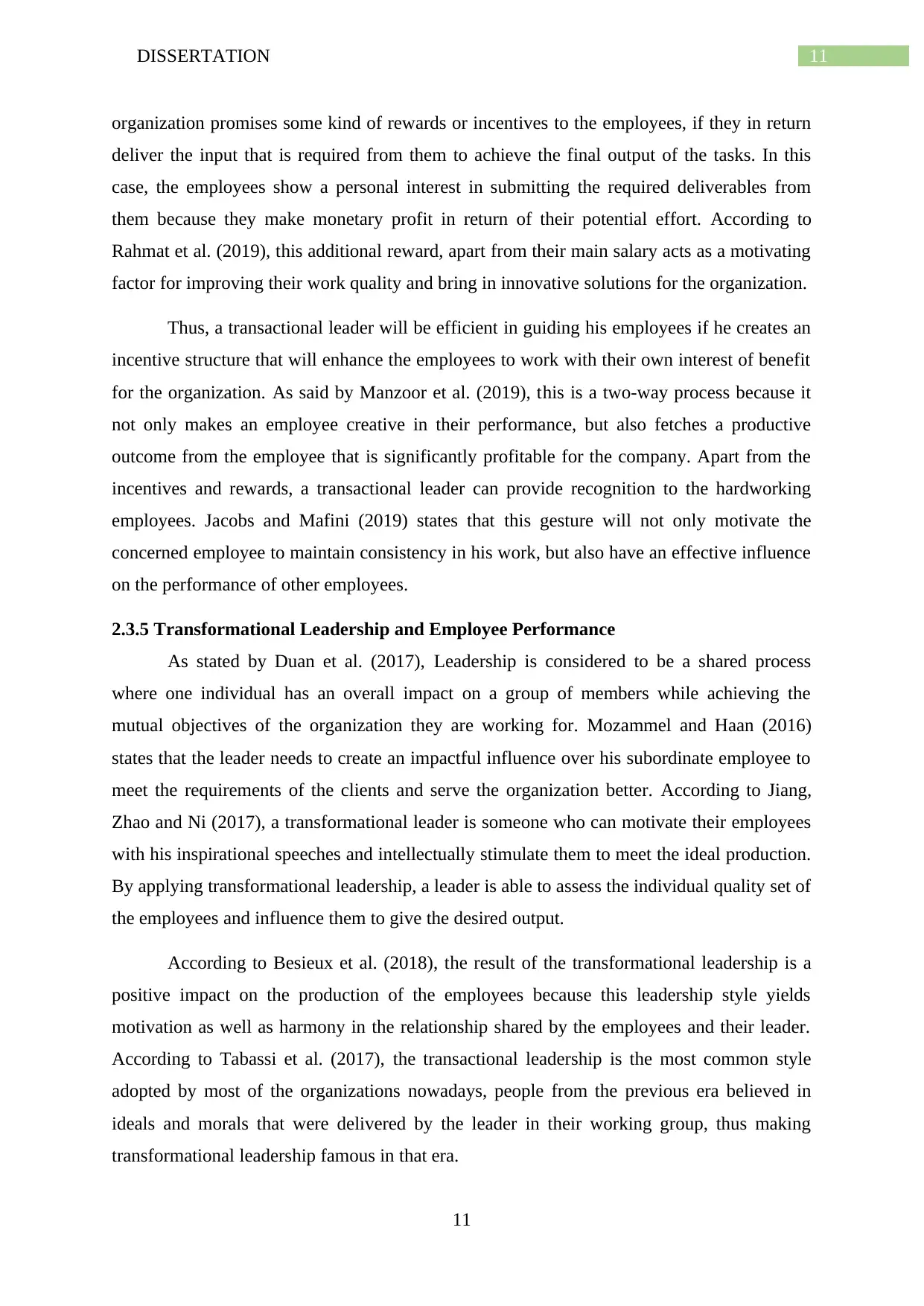
11DISSERTATION
organization promises some kind of rewards or incentives to the employees, if they in return
deliver the input that is required from them to achieve the final output of the tasks. In this
case, the employees show a personal interest in submitting the required deliverables from
them because they make monetary profit in return of their potential effort. According to
Rahmat et al. (2019), this additional reward, apart from their main salary acts as a motivating
factor for improving their work quality and bring in innovative solutions for the organization.
Thus, a transactional leader will be efficient in guiding his employees if he creates an
incentive structure that will enhance the employees to work with their own interest of benefit
for the organization. As said by Manzoor et al. (2019), this is a two-way process because it
not only makes an employee creative in their performance, but also fetches a productive
outcome from the employee that is significantly profitable for the company. Apart from the
incentives and rewards, a transactional leader can provide recognition to the hardworking
employees. Jacobs and Mafini (2019) states that this gesture will not only motivate the
concerned employee to maintain consistency in his work, but also have an effective influence
on the performance of other employees.
2.3.5 Transformational Leadership and Employee Performance
As stated by Duan et al. (2017), Leadership is considered to be a shared process
where one individual has an overall impact on a group of members while achieving the
mutual objectives of the organization they are working for. Mozammel and Haan (2016)
states that the leader needs to create an impactful influence over his subordinate employee to
meet the requirements of the clients and serve the organization better. According to Jiang,
Zhao and Ni (2017), a transformational leader is someone who can motivate their employees
with his inspirational speeches and intellectually stimulate them to meet the ideal production.
By applying transformational leadership, a leader is able to assess the individual quality set of
the employees and influence them to give the desired output.
According to Besieux et al. (2018), the result of the transformational leadership is a
positive impact on the production of the employees because this leadership style yields
motivation as well as harmony in the relationship shared by the employees and their leader.
According to Tabassi et al. (2017), the transactional leadership is the most common style
adopted by most of the organizations nowadays, people from the previous era believed in
ideals and morals that were delivered by the leader in their working group, thus making
transformational leadership famous in that era.
11
organization promises some kind of rewards or incentives to the employees, if they in return
deliver the input that is required from them to achieve the final output of the tasks. In this
case, the employees show a personal interest in submitting the required deliverables from
them because they make monetary profit in return of their potential effort. According to
Rahmat et al. (2019), this additional reward, apart from their main salary acts as a motivating
factor for improving their work quality and bring in innovative solutions for the organization.
Thus, a transactional leader will be efficient in guiding his employees if he creates an
incentive structure that will enhance the employees to work with their own interest of benefit
for the organization. As said by Manzoor et al. (2019), this is a two-way process because it
not only makes an employee creative in their performance, but also fetches a productive
outcome from the employee that is significantly profitable for the company. Apart from the
incentives and rewards, a transactional leader can provide recognition to the hardworking
employees. Jacobs and Mafini (2019) states that this gesture will not only motivate the
concerned employee to maintain consistency in his work, but also have an effective influence
on the performance of other employees.
2.3.5 Transformational Leadership and Employee Performance
As stated by Duan et al. (2017), Leadership is considered to be a shared process
where one individual has an overall impact on a group of members while achieving the
mutual objectives of the organization they are working for. Mozammel and Haan (2016)
states that the leader needs to create an impactful influence over his subordinate employee to
meet the requirements of the clients and serve the organization better. According to Jiang,
Zhao and Ni (2017), a transformational leader is someone who can motivate their employees
with his inspirational speeches and intellectually stimulate them to meet the ideal production.
By applying transformational leadership, a leader is able to assess the individual quality set of
the employees and influence them to give the desired output.
According to Besieux et al. (2018), the result of the transformational leadership is a
positive impact on the production of the employees because this leadership style yields
motivation as well as harmony in the relationship shared by the employees and their leader.
According to Tabassi et al. (2017), the transactional leadership is the most common style
adopted by most of the organizations nowadays, people from the previous era believed in
ideals and morals that were delivered by the leader in their working group, thus making
transformational leadership famous in that era.
11
⊘ This is a preview!⊘
Do you want full access?
Subscribe today to unlock all pages.

Trusted by 1+ million students worldwide
1 out of 42
Related Documents
Your All-in-One AI-Powered Toolkit for Academic Success.
+13062052269
info@desklib.com
Available 24*7 on WhatsApp / Email
![[object Object]](/_next/static/media/star-bottom.7253800d.svg)
Unlock your academic potential
Copyright © 2020–2026 A2Z Services. All Rights Reserved. Developed and managed by ZUCOL.





